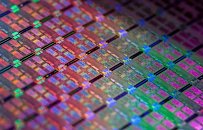- Joined
- Oct 9, 2007
- Messages
- 47,189 (7.56/day)
- Location
- Hyderabad, India
| System Name | RBMK-1000 |
|---|---|
| Processor | AMD Ryzen 7 5700G |
| Motherboard | ASUS ROG Strix B450-E Gaming |
| Cooling | DeepCool Gammax L240 V2 |
| Memory | 2x 8GB G.Skill Sniper X |
| Video Card(s) | Palit GeForce RTX 2080 SUPER GameRock |
| Storage | Western Digital Black NVMe 512GB |
| Display(s) | BenQ 1440p 60 Hz 27-inch |
| Case | Corsair Carbide 100R |
| Audio Device(s) | ASUS SupremeFX S1220A |
| Power Supply | Cooler Master MWE Gold 650W |
| Mouse | ASUS ROG Strix Impact |
| Keyboard | Gamdias Hermes E2 |
| Software | Windows 11 Pro |
If Intel's now-defunct "tick-tock" product development cadence held its ground, the 14 nm silicon fabrication node should have seen just two micro-architectures, "Broadwell" and "Skylake," with "Broadwell" being an incrementally improved optical shrink of 22 nm "Haswell," and "Skylake" being a newer micro-architecture built on a then more matured 14 nm node. Intel's silicon fabrication node advancement went off the rails in 2015-16, and 14 nm would go on to be the base for three more "generations," including the 7th generation "Kaby Lake," the 8th generation "Coffee Lake," and 9th generation "Coffee Lake Refresh." The latter two saw Intel increase core-counts after AMD broke its slumber. It turns out that Intel won't let the 8-core "Coffee Lake Refresh" die pull the weight of Intel's competitiveness and prestige through 2019, and is planning yet another stopgap, codenamed "Comet Lake."
Intel's next silicon fabrication node, 10 nm, takes off only toward the end of 2019, and AMD is expected to launch its 7 nm "Zen 2" architecture much sooner than that (debuts in December 2018). Intel probably fears AMD could launch client-segment "Zen 2" processors before Intel's first 10 nm client-segment products, to cash in on its competitive edge. Intel is looking to blunt that with "Comet Lake." Designed for the LGA115x mainstream-desktop platform, "Comet Lake" is a 10-core processor die built on 14 nm, and could be the foundation of the 10th generation Core processor family. It's unlikely that the underlying core design is changed from "Skylake" (circa 2016). It could retain the same cache hierarchy, with 256 KB per core L2 cache, and 20 MB shared L3 cache. All is not rosy in the AMD camp. The first AMD 7 nm processors will target the enterprise segment and not client, and CEO Lisa Su in her quarterly financial results calls has been evasive about when the first 7 nm client-segment products could come out. There was some chatter in September of a "Zen+" based 10-core socket AM4 product leading up to them.

View at TechPowerUp Main Site
Intel's next silicon fabrication node, 10 nm, takes off only toward the end of 2019, and AMD is expected to launch its 7 nm "Zen 2" architecture much sooner than that (debuts in December 2018). Intel probably fears AMD could launch client-segment "Zen 2" processors before Intel's first 10 nm client-segment products, to cash in on its competitive edge. Intel is looking to blunt that with "Comet Lake." Designed for the LGA115x mainstream-desktop platform, "Comet Lake" is a 10-core processor die built on 14 nm, and could be the foundation of the 10th generation Core processor family. It's unlikely that the underlying core design is changed from "Skylake" (circa 2016). It could retain the same cache hierarchy, with 256 KB per core L2 cache, and 20 MB shared L3 cache. All is not rosy in the AMD camp. The first AMD 7 nm processors will target the enterprise segment and not client, and CEO Lisa Su in her quarterly financial results calls has been evasive about when the first 7 nm client-segment products could come out. There was some chatter in September of a "Zen+" based 10-core socket AM4 product leading up to them.

View at TechPowerUp Main Site








